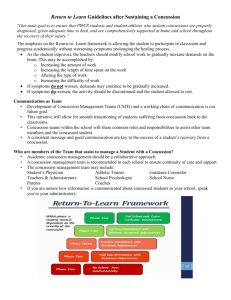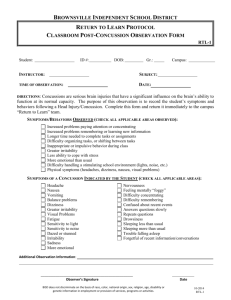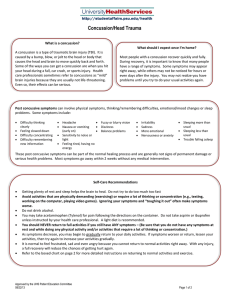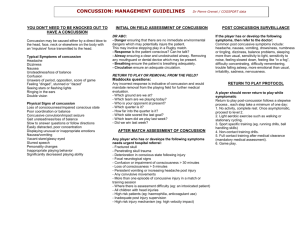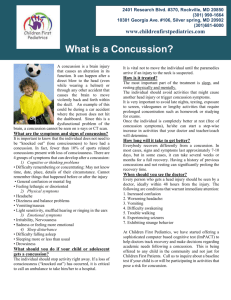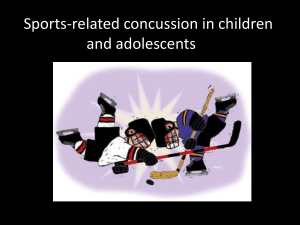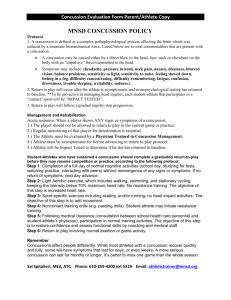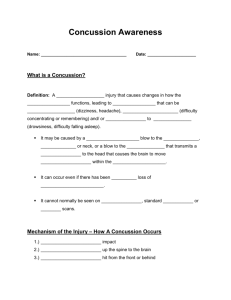Concussion Information - Bayville Locust Valley Little League
advertisement
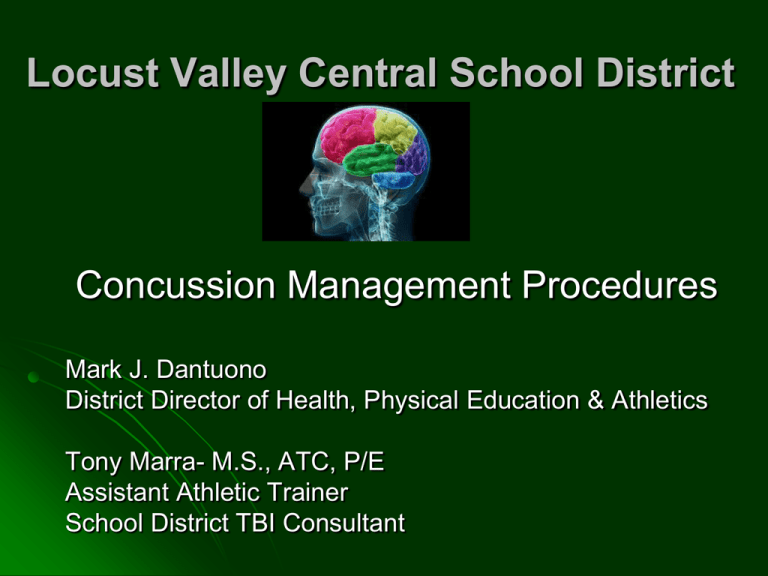
Locust Valley Central School District Concussion Management Procedures Mark J. Dantuono District Director of Health, Physical Education & Athletics Tony Marra- M.S., ATC, P/E Assistant Athletic Trainer School District TBI Consultant Concussion Management Awareness Act NYS created and implemented this new law effective July 1, 2012. As a result, all school coaches, physical education teachers, nurses and athletic trainers must on a biennial basis complete the training certification program. This program will include recognizing the symptoms pertaining to traumatic brain injuries and the monitoring and seeking the proper treatment for students who experience mild traumatic brain injuries. Definition of a Concussion What is a concussion?- Is a brain injury that is caused by a bump or blow to the head. How can it occur?- May occur from a fall or blow to the body that causes the head to move rapidly back and forth. Definition of Second Impact Syndrome A potential catastrophic medical emergency where a 2nd concussion is sustained while symptomatic from the initial concussion. Both injuries can occur within a same event, very common to people under 20 years of age. As a result may create massive pressure to the brain which can lead to brain damage and or death. Post -Traumatic Concussion Syndrome Persistent post-concussion symptoms lasting weeks, months or even years after a concussion. How Concussions May Occur in a School Setting Classroom- Desk(top or bottom), door, trip/fall and or collision with another person or object. PE Class- Collision with another student or non-moving object (wall), moving objects such as basketball or soccer balls. Recess- Outdoor equipment which will include swings, slides, monkey bars, rings and climbing ropes. Signs and Symptoms Signs observed by school professionals: Appears dazed or stunned Is confused about events Answers questions slowly Repeats questions Can’t recall events after hit, bump or fall Loses consciousness (even briefly) Signs and Symptoms (cont.) Symptoms reported by students Thinking/Remembering Difficulty thinking clearly Difficulty concentrating or remembering Feeling sluggish, foggy or groggy Physical Headache or “pressure” in head Nausea or vomiting Balance problems or dizziness Fatigue or feeling tired Blurry or double vision Sensitivity to light or noise Emergency Procedures 1. Observe body position of the child: face up/down, sitting, or standing unbalanced 2. Radio or contact school nurse immediately. 3. Do not move or have anyone else move student. (If student is unconscious call 911) Responsibilities of Parent and School Staff dealing with a concussed child/student ParentsObserve daily child behavior Observe sleeping/eating behaviors and physical symptoms (dizziness and headaches) Eliminate the use of all electronic devices (TV, computer, IPAD/gaming devices and cell phone usage) Observe emotional behavior (irritability, sadness/crying and nervousness) Responsibilities of Parent and School Staff dealing with a concussed child/student-cont. School StaffObserve academic performance (difficulty concentrating, remembering or thinking clearly) Observe light and noise sensitivity, headaches and dizziness. Observe emotional behavior (irritability, sadness/crying and nervousness) NYS Return to Play Protocol In the event a child is concussed, he or she may not return to physical activities and physical education class until the 6-stage return to play protocol is administered and completed by the school nurse and physical education teacher. Elementary Return to Play Protocol Locust Valley School District T.B.I. Primary/Intermediate Level Return To Play Protocol Name:_____________________D.O.I.: AGE: , Max HR:____ , Dx. Date: STAGE 1: Very Light Aerobic Activities (30-40% max effort) 10-15 minutes of cardio exercise in a low stimulus environment; limiting head movement and concentration activities. Example: walking stationary bike. STAGE 2: Moderate Aerobic Activities (40-60% max effort) 20-30 minutes of cardio exercise and light strengthening in a gym environment, allowing some positional changes and head movement: low level concentration activities. Example: light jogging or stationary bike, light weight training, and . balance training with limited hand/eye coordination Elementary Return to Play Protocol (cont.) STAGE 3: Moderately Aggressive Aerobic Activities (60-80% max effort) Balance and strength training at 80% effort. Proprioceptive activities to incorporate concentration activities. Example: running/sprinting, stationary bike, and plyometrics, STAGE 4: Sports Performance Training (80-90% max effort) Training in sports specific activities, increasing hand/eye coordination. Example: student may increase training with multiple head, hand, and eye coordination skills. STAGE 5: Full Unrestricted Performance Training Student may return to ALL school related activities. Example: full unrestricted participation in P.E. classes ONLY. NO outside activities Elementary Return to Play Protocol (cont.) STAGE 6: Full Unrestricted Activities Return to full activities, BOTH in and out of school environment. Approved and authorized by LVCSD Physicians, the above stages must be implemented by School Nurse and Physical Education Teacher.
